The Game Simulation of “The Belt and Road” Economic and Trade Network Based on the Asymmetric QRE Model
Abstract
1. Introduction
2. Methodology
2.1. “The Belt and Road” Complex Network
2.2. Asymmetrical QRE Model
3. The Network Game Model
3.1. Model Assumptions
- R > P. Game players prefer to cooperate together rather than betray each other.
- R > S. Game players prefer to cooperate together rather than unilaterally.
- 2R > T + S, the benefits of joint cooperation are greater than the collective benefits of unilateral cooperation or unilateral betrayal.
- T > R or P > S, the players prefer to betray unilaterally rather than cooperate together or the players prefer to betray jointly rather than cooperate unilaterally.
3.2. Model Analysis
4. Analysis of Simulation Results
4.1. The Belief in the Sensitivity to Own Payoff ()
4.2. The Belief in the Sensitivity to Counterparts ()
4.3. The Reward for Cooperation by Neighbor Nodes (w)
4.4. The Trade Facilitation Index (f)
4.5. The Reduction Rate of Tariff (r)
5. Discussion and Conclusion
5.1. Discussion
5.2. Conclusions
- (1)
- The sensitivity of own payoff and the sensitivity of his counterparts has little influence on the stable number of cooperators in “The Belt and Road” economic and trade network within a limited range of value. This may be the role played by the increasingly rational and mature decision-making process in various countries. At the same time, it means that subjective factors only have an impact on cooperation between countries under some specific conditions. Therefore, when considering promoting the development of an overall trade network, countries should not put subjective factors at the top of their worries.
- (2)
- The rewards of neighbor have a significant impact on the cooperation of “The Belt and Road”. Because the neighboring countries in the network are the countries that have close trade relations with each other in reality, this shows that the change of a country’s cooperation strategy will first affect those countries which have close trade ties with it. Therefore, countries should first actively communicate with existing trading partners and pursue a higher-level cooperation on the basis of maintaining the existing stable trade relations. At the same time, this also means that the trade network structure has a great influence on the cooperation of “The Belt and Road”. Therefore, countries should also strive to improve their position in the trade network in order to obtain more opportunities for trade cooperation.
- (3)
- The level of trade facilitation measures other than the neighbor’s rewards is beneficial to the cooperative behavior of “The Belt and Road”. The extensive construction of infrastructure such as roads, railways and the Internet will greatly enhance the level of trade facilitation of the entire network, and will further promote the emergence and development of trade cooperation among countries in the network. Therefore, countries along “The Belt and Road” must attach importance to infrastructure construction and attract more cooperation by improving their trade facilitation level, thereby improving their trade status and promoting trade prosperity.
- (4)
- Tariff relief has a significant effect on the cooperative behavior in “The Belt and Road” network. As a traditional trade protection measure, high-level tariffs have become the most frequently adopted trade protection policy in today’s anti-globalization tide. However, it has been proved that only low-level tariff and trade liberalization can promote the emergence of trade cooperation between countries, thereby promoting the development and prosperity of the world’s economies. Compared with measures of trade protection with high tariffs, countries should maintain an open and inclusive attitude and actively carry out trade cooperation and exchanges with other countries in order to achieve healthy and sustainable development of their trade.
- (5)
- The cooperative behavior in “The Belt and Road” network is the result of the combined effects of many factors. We set a reasonable initial value in the statistical sense, so we obtained a more obvious trend of simulation results. However, in reality, the effect of cooperation will be affected by many other factors, but the trend of the impact of the factors we tested on the results was determined.
- (6)
- Our research has some limitations. First, although the influence of the asymmetry of cognition on the equilibrium of the network game was taken into account, the assumption that countries are homogeneous and rational is still too idealistic, which is different from the reality of the countries of “The Belt and Road”. Second, the study assumes that the trade network structure is static, but the real trade network is dynamic, and changes in the network structure will influence policy choices. In a future study, we will relax the assumptions, take into account the size of the countries, the social and cultural differences, and other factors, while the weighted network will be used to enhance the reality of the game results.
Author Contributions
Funding
Conflicts of Interest
Appendix A
| The Basic Algorithm Code of Simulation |
| clear; |
| clc; |
| C= [1,0]; |
| D= [0,1; |
| R=5; |
| S=-2; |
| T=6; |
| W=3; |
| A = [R S; T W]; |
| w=0.5; |
| f=0.5; |
| r=1; |
| lamda1=0.2; |
| lamda2=0.2; |
| nums=65; |
| load(‘a.mat’); |
| load(‘gdp.mat’); |
| load(‘trade.mat’); |
| P0=0.5; |
| P (1) = P0; |
| K = [6 9 9 31 27 33 44 2 18 8 46 14 63 33 ... |
| 17 54 26 19 46 50 61 46 42 20 36 27 36 ... |
| 27 10 4 30 19 35 50 2 2 8 17 4 27 41 27 ... |
| 57 28 17 50 57 42 31 54 47 47 30 3 19 10 ... |
| 53 18 59 23 55 50 26 47 15] ; |
| t=1; |
| times=10; |
| for i=1: nums |
| Nlc(1, i)=K(i)*P0; |
| end |
| h=0: times; |
| length(h) |
| TNc(1)=nums*P0; |
| for i=1: nums |
| if rand (1) <=P0 |
| Ent(i).CD=C; |
| else |
| Ent(i).CD=D; |
| end |
| end |
| for t=1: length(h) |
| FZ1(t)=exp(lamda1*(P(t)*R+(1-P(t)) *S)); |
| FM1(t)=exp(lamda1*(P(t)*R+(1-P(t)) *S)) +exp(lamda1*(P(t)*T+(1-P(t)) *W)); |
| P1(t)=FZ1(t)/FM1(t); |
| FZ2(t)=exp(lamda2*(P1(t)*R+(1-P1(t)) *S)); |
| FM2(t)=exp(lamda2*(P1(t)*R+(1-P1(t)) *S)) +exp(lamda2*(P1(t)*T+(1-P1(t)) *W)); |
| P(t+1) =FZ2(t)/FM2(t); |
| for i=1: nums |
| UC(i)=0; |
| UD(i)=0; |
| for j=1: nums |
| UC(i)=C*A*C’*P1(t)*a(i,j)+C*A*D’*(1-P1(t))*a(i,j)+UC(i); |
| UD(i)=D*A*C’*P1(t)*a(i,j)+D*A*D’*(1-P1(t))*a(i,j)+UD(i); |
| end |
| newUC(i)=UC(i)+w*Nlc(t,i)+f*gdp(i)+r*trade(i); |
| Usum(i)=newUC(i)-UD(i); |
| if Usum(i)>=0 |
| Ent(i).CD=C; |
| else |
| Ent(i).CD=D; |
| end |
| end |
| for i=1: nums |
| Nlccount=0; |
| for j=1: nums |
| if Ent(j).CD==C |
| if a(i,j)==1 |
| Nlccount=Nlccount+1; |
| end |
| end |
| end |
| Nlc(t+1, i)=Nlccount;%ÁÚ¾ÓÖеĺÏ×÷ÕßÊýÁ¿ |
| end |
| ccount=0; |
| for j=1: nums |
| if Ent(j).CD==C |
| ccount=ccount+1; |
| end |
| end |
| TNc(t+1) =ccount; |
| end |
legend () |
xlabel(’t’) |
ylabel(’The number of collaborators Nc’) |
title ({[’’]}) |
plot(h,TNc(1:times+1),’-ok’) |
hold on |
References
- The Belt and Road Initiative Progress, Contributions and Prospects. Available online: https://eng.yidaiyilu.gov.cn/zchj/qwfb/86739.htm (accessed on 12 May 2019).
- The “New Silk Road” Initiative: China’s Marshall Plan? Available online: http://www.ciis.org.cn/english/2015-06/11/content_7982914.htm (accessed on 12 May 2019).
- “One Belt One Road”: China at the Centre of the Global Geopolitics and Geo-economics? Available online: http://www.southasiaanalysis.org/node/1672 (accessed on 12 May 2019).
- China Bypasses American ‘New Silk Road’ with Two if Its Own. Available online: https://www.washingtonpost.com/world/asia_pacific/china-bypasses-american-new-silk-road-with-two-if-its-own/2013/10/14/49f9f60c-3284-11e3-ad00-ec4c6b31cbed_story.html?noredirect=on&utm_term=.612382875a54 (accessed on 12 May 2019).
- Tiezzi, S. The maritime silk road vs. the string of pearls. Diplomat 2014, 13, 104. [Google Scholar]
- Tuo, C. Global Governance and State Governance: Two Strategic Considerations in Contemporary China. Soc. Sci. China 2016, 37, 138–151. [Google Scholar] [CrossRef]
- Ling, S.L. The Strategy of the Belt and Road Initiatives and the Reshaping of the Peripheral Geopolitics. J. Int. Relat. 2016, 1, 79–91. (In Chinese) [Google Scholar]
- Liu, W.; Dunford, M. Inclusive globalization: Unpacking China’s belt and road initiative. Area Dev. Policy 2016, 1, 323–340. [Google Scholar] [CrossRef]
- Guo, X. A Study on the International Tourism of Jiangxi Province under the Guidance of One Belt, One Road Strategy. Econ. Soc. Chang. 2016, 3, 221–230. [Google Scholar] [CrossRef]
- Andornino, G.B. The Belt and Road Initiative in China’s Emerging Grand Strategy of Connective Leadership. China World Econ. 2017, 25, 4–22. [Google Scholar] [CrossRef]
- Kenderdine, T. Death of the East Asian Goose and the Rise of China’s Geoindustrial Policy. J. Chin. Polit. Sci. 2018, 23, 437–453. [Google Scholar] [CrossRef]
- Yu, Y.; Darko, A.; Chan, A.P.; Chen, C.; Bao, F. Evaluation and Ranking of Risk Factors in Transnational Public–Private Partnerships Projects: Case Study Based on the Intuitionistic Fuzzy Analytic Hierarchy Process. J. Infrastruct. Syst. 2018, 24, 04018028. [Google Scholar] [CrossRef]
- Fung, K.C.; Aminian, N.; Fu, X.; Kornhohen, I. Internationalization of the use of Chinese currency: Perspectives from the New and the Ancient Silk Roads. J. Chin. Econ. Bus. Stud. 2018, 16, 1–16. [Google Scholar] [CrossRef]
- Li, K.X.; Jin, M.; Qi, G.; Shi, W.; Ng, A.K. Logistics as a driving force for development under the Belt and Road Initiative–the Chinese model for developing countries. Transp. Rev. 2018, 38, 457–478. [Google Scholar] [CrossRef]
- Chen, C.C.; Chen, C.W.; Tung, Y.C. Exploring the consumer behavior of intention to purchase green products in belt and road countries: An empirical analysis. Sustainability 2018, 10, 854. [Google Scholar] [CrossRef]
- Lin, M. India’s recognition of “the Belt and Road” and China’s policy options. World Econ. Polit. 2015, 5, 42–57. (In Chinese) [Google Scholar]
- Yao, R.; Bai, H.; Xu, H. Where should China’s thermal power industry prioritize its B&R investment? A study based on an environmental site selection analysis. J. Clean. Prod. 2019, 215, 669–679. [Google Scholar]
- Xu, H.; Sun, T.; Cheng, L. Trade Patterns and Influence Factors of High-end Manufacturing on the Belt and Road. Financ. Trade Econ. 2015, 12, 74–88. (In Chinese) [Google Scholar]
- Fu, X.M.; Chen, H.X.; Xue, Z.K. Construction of the belt and road trade cooperation network from the multi-distances perspective. Sustainability 2018, 10, 1439. [Google Scholar] [CrossRef]
- McKelvey, R.D.; Palfrey, T.R. Quantal response equilibria for normal form games. Games Econ. Behav. 1995, 10, 6–38. [Google Scholar] [CrossRef]
- Friston, K.; Schwartenbeck, P.; FitzGerald, T.; Moutoussis, M.; Behrens, T.; Dolan, R.J. The anatomy of choice: Dopamine and decision-making. Philos. Trans. R. Soc. B Biol. Sci. 2014, 369, 20130481. [Google Scholar] [CrossRef]
- Lim, N.; Ho, T.H. Designing price contracts for boundedly rational customers: Does the number of blocks matter? Mark. Sci. 2007, 26, 312–326. [Google Scholar] [CrossRef]
- Ho, T.H.; Zhang, J. Designing pricing contracts for boundedly rational customers: Does the framing of the fixed fee matter? Manag. Sci. 2008, 54, 686–700. [Google Scholar] [CrossRef]
- Guarnaschelli, S.; McKelvey, R.D.; Palfrey, T.R. An experimental study of jury decision rules. Am. Polit. Sci. Rev. 2000, 94, 407–423. [Google Scholar] [CrossRef]
- Levine, D.K.; Palfrey, T.R. The paradox of voter participation? A laboratory study. Am. Polit. Sci. Rev. 2007, 101, 143–158. [Google Scholar] [CrossRef]
- Choi, S.; Gale, D.; Kariv, S. Sequential equilibrium in monotone games: A theory-based analysis of experimental data. J. Econ. Theory 2008, 143, 302–330. [Google Scholar] [CrossRef]
- Tumennasan, N. To err is human: Implementation in quantal response equilibria. Games Econ. Behav. 2013, 77, 138–152. [Google Scholar] [CrossRef]
- Golman, R. Quantal response equilibria with heterogeneous agents. J. Econ. Theory 2011, 146, 2013–2028. [Google Scholar] [CrossRef]
- Goeree, J.K.; Holt, C.A.; Palfrey, T.R. Quantal response equilibrium and overbidding in private-value auctions. J. Econ. Theory 2002, 104, 247–272. [Google Scholar] [CrossRef]
- Neri, C. Quantal response equilibrium in a double auction. Econ. Theory Bull. 2015, 3, 79–90. [Google Scholar] [CrossRef]
- Bandyopadhyay, S.; Coughlin, C.C.; Wall, H.J. Ethnic networks and US exports. Rev. Int. Econ. 2008, 16, 199–213. [Google Scholar] [CrossRef]
- Reimer, J.J.; Zhang, X. An economic model of search and matching in international trade. Rev. Int. Econ. 2018, 26, 784–800. [Google Scholar] [CrossRef]
- Schoenenberger, L.; Tanase, R. Controlling complex policy problems: A multimethodological approach using system dynamics and network controllability. J. Simul. 2018, 12, 162–170. [Google Scholar] [CrossRef]
- Ribino, P.; Cossentino, M.; Lodato, C.; Lopes, S. Agent-based simulation study for improving logistic warehouse performance. J. Simul. 2018, 12, 23–41. [Google Scholar] [CrossRef]
- Junior, W.L.; Rosário, D.; Cerqueira, E.; Villas, L.A.; Gerla, M. A Game Theory Approach for Platoon-Based Driving for Multimedia Transmission in VANETs. Wirel. Commun. Mob. Comput. 2018, 2018. [Google Scholar] [CrossRef]
- Pellan, M.I.; Wong, M.H. Trade facilitation in ASEAN and ASEAN+ 1 FTAS: An analysis of provisions and progress. J. World Trade 2013, 47, 243. [Google Scholar]
- Gowa, J.; Hicks, R. “Big” Treaties, Small Effects: The RTAA Agreements. World Polit. 2018, 70, 165–193. [Google Scholar] [CrossRef]
- Promote the Construction of the Silk Road Economic Belt and the Vision and Action of the Maritime Silk Road in 21st Century. Available online: http://www.mofcom.gov.cn/article/i/jyjl/k/201504/20150400930662.shtml (accessed on 12 May 2019).
- UNCTDs. Available online: http://unctad.org/en/Pages/statistics.aspx (accessed on 4 May 2019).
- Anderson, S.P.; Goeree, J.K.; Holt, C.A. The logit equilibrium: A perspective on intuitive behavioral anomalies. South. Econ. J. 2002, 21–47. [Google Scholar] [CrossRef][Green Version]
- Hofbauer, J.; Sigmund, K. Evolutionary game dynamics. Bull. Am. Math. Soc. 2003, 40, 479–519. [Google Scholar] [CrossRef]
- Sankaranarayanan, K.; Delgado, C.; Van Ackere, A.; Larsen, E.R. The micro-dynamics of queuing: Understanding the formation of queues. J. Simul. 2014, 8, 304–313. [Google Scholar] [CrossRef]
- Facchinei, F.; Kanzow, C. Generalized Nash equilibrium problems. 4OR 2007, 5, 173–210. [Google Scholar] [CrossRef]
- Choi, S.; Gale, D.; Kariv, S. Social learning in networks: A quantal response equilibrium analysis of experimental data. Rev. Econ. Des. 2012, 16, 135–157. [Google Scholar] [CrossRef]
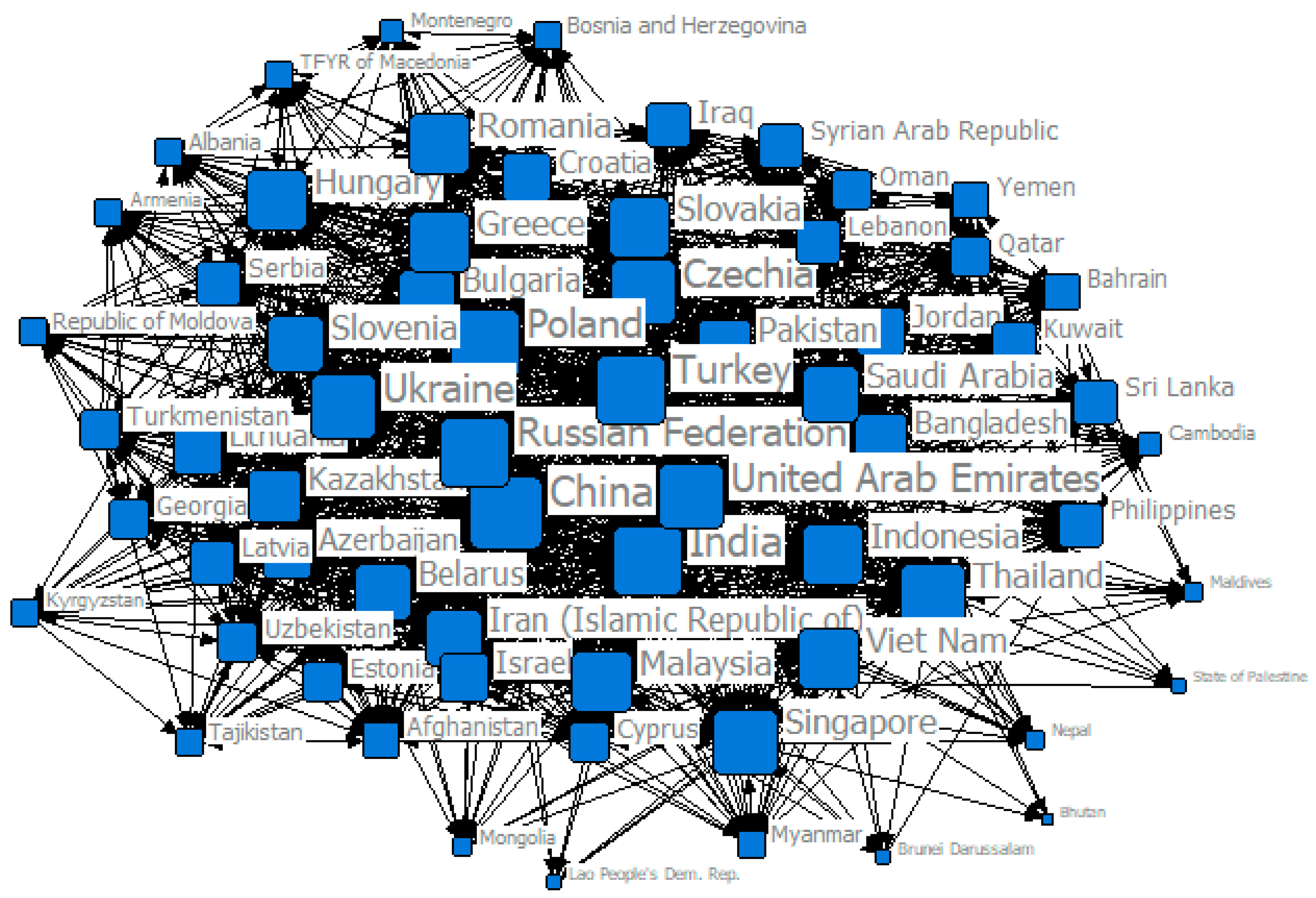
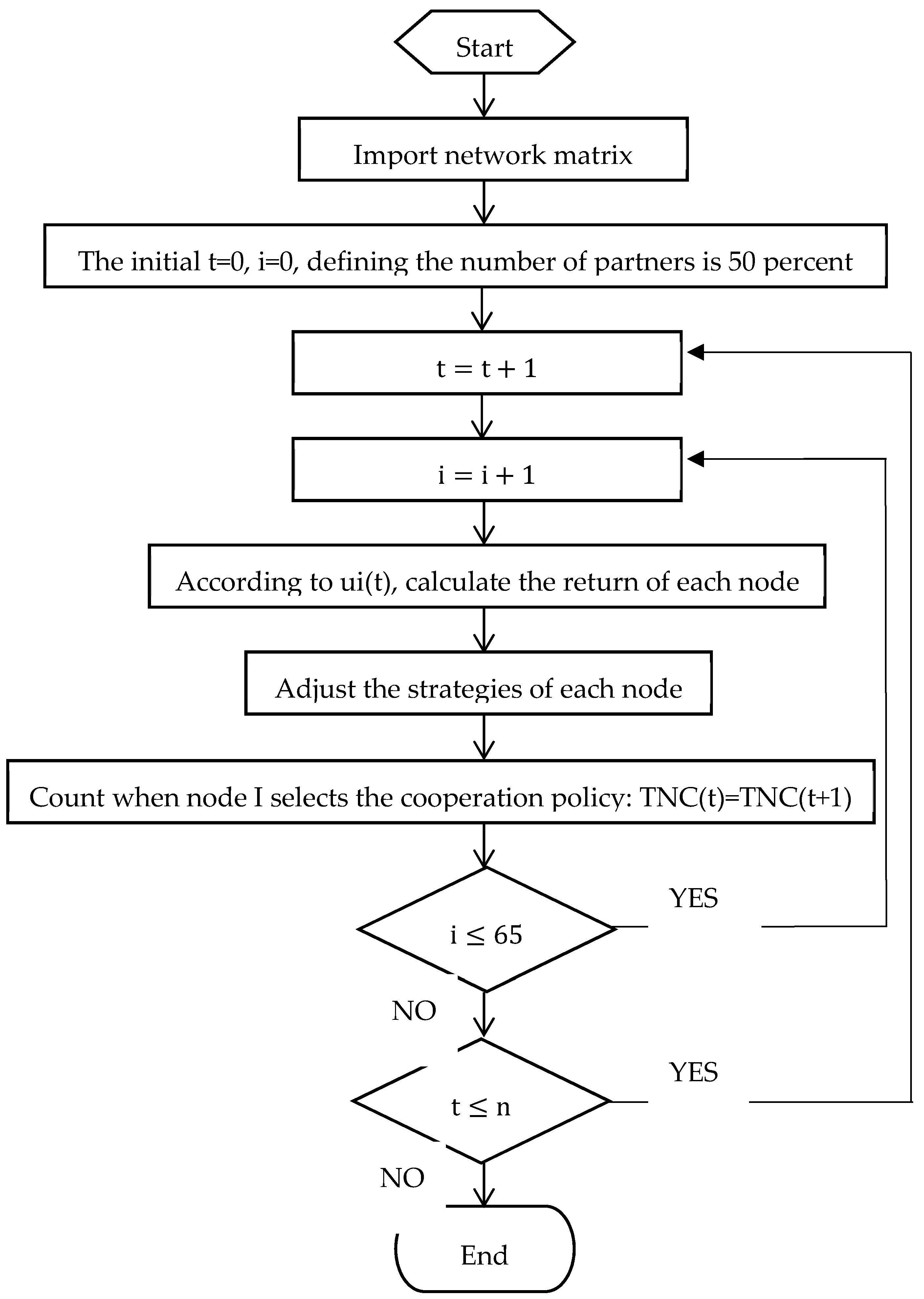
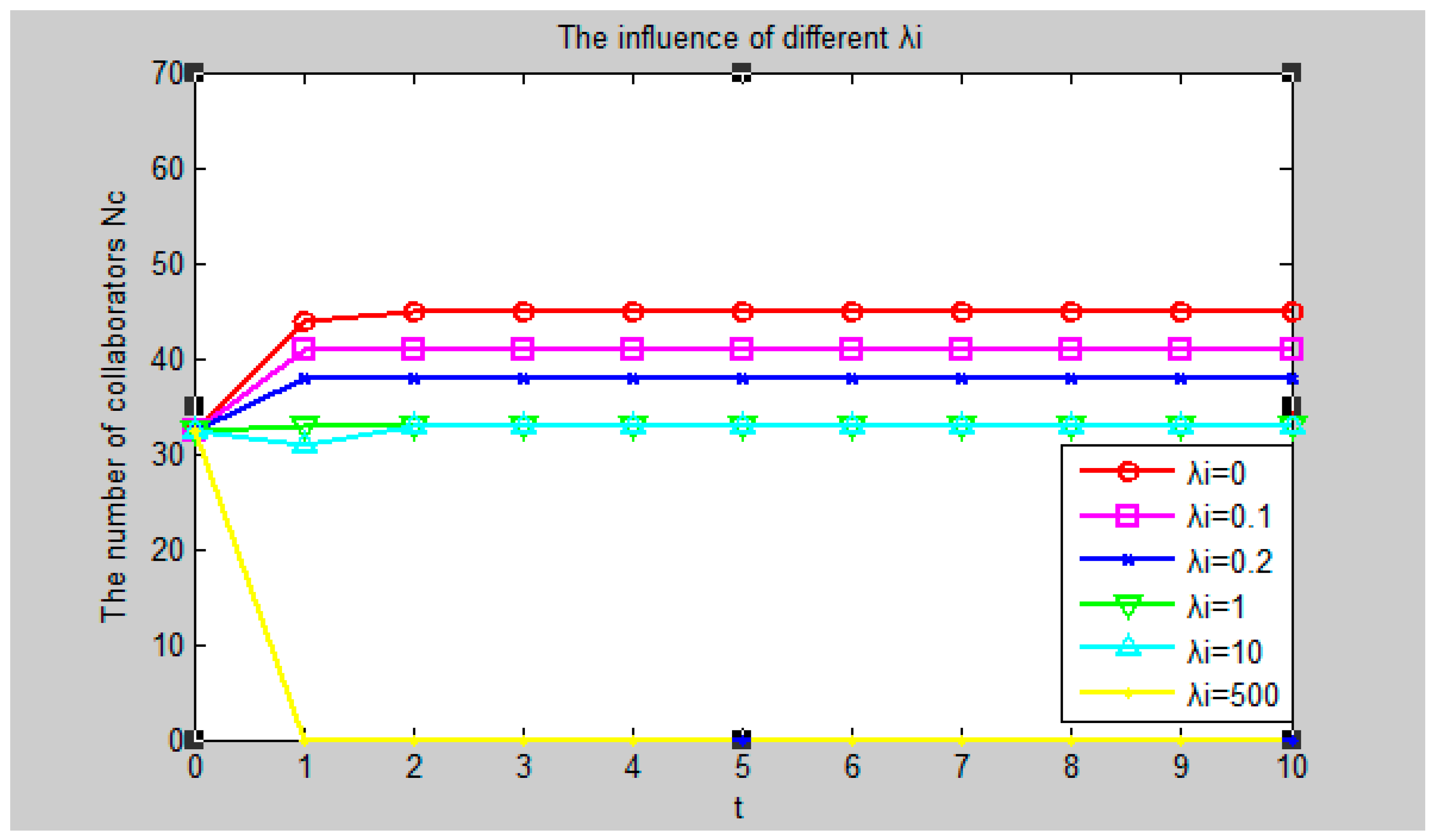
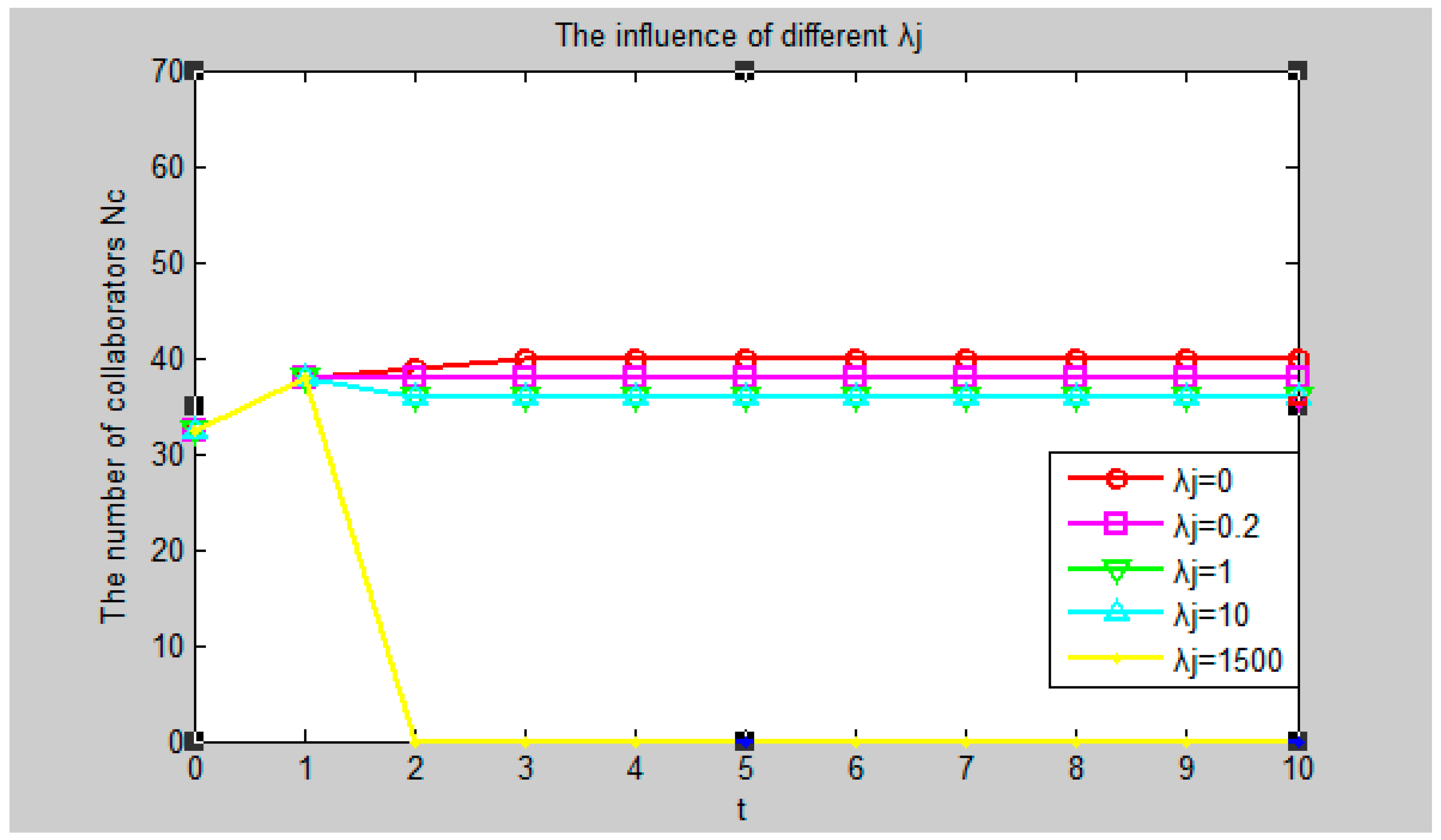
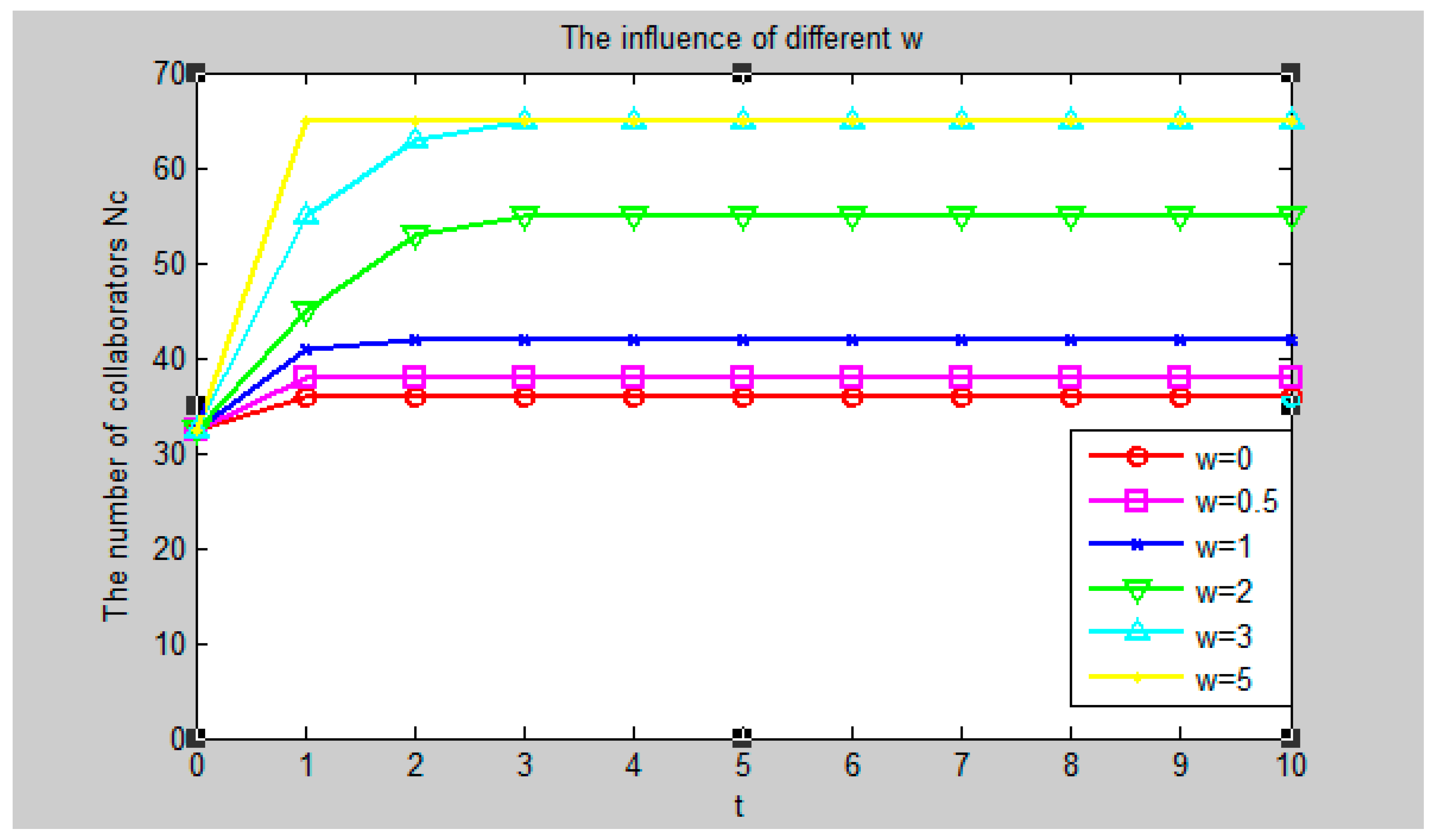
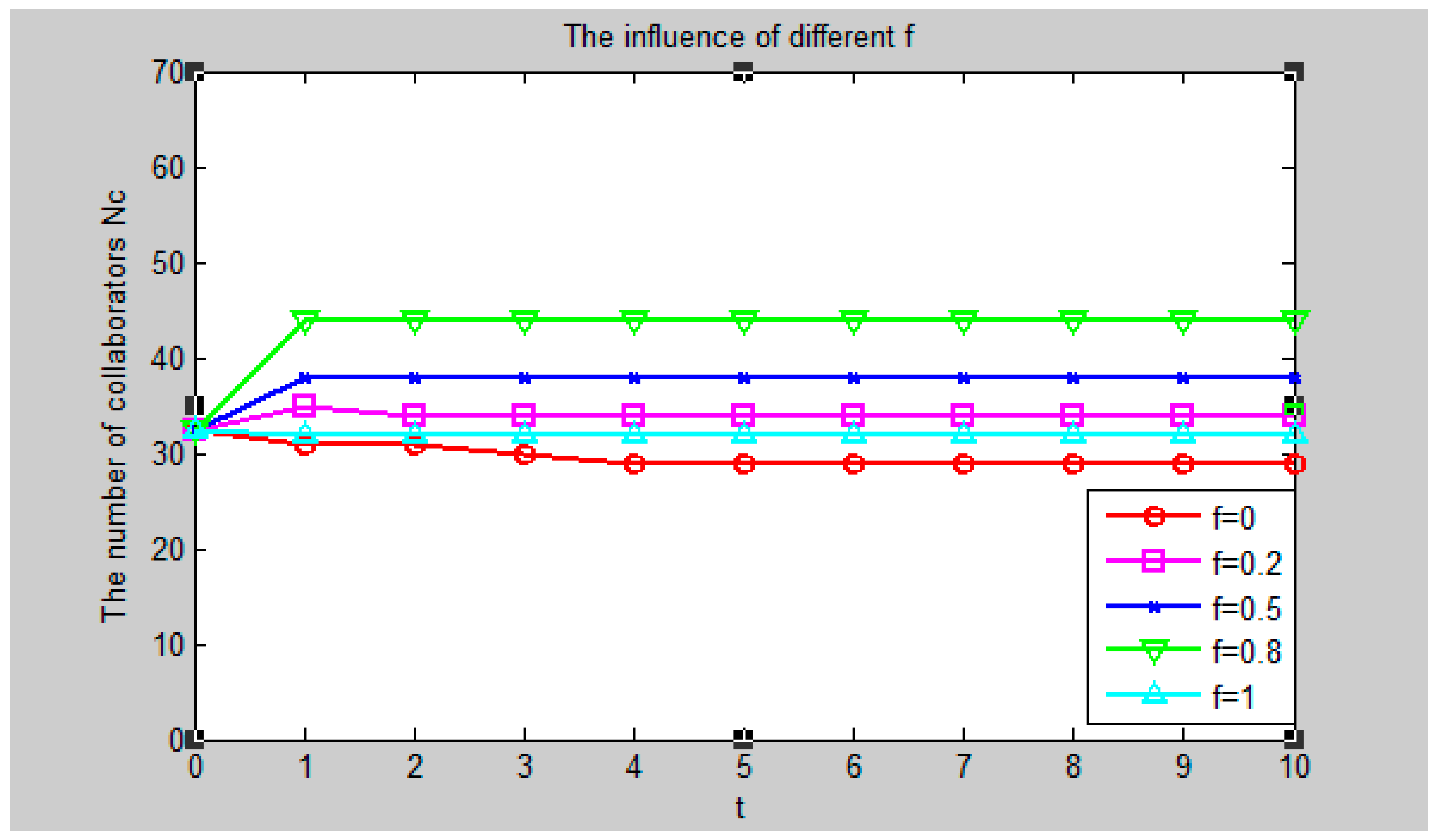
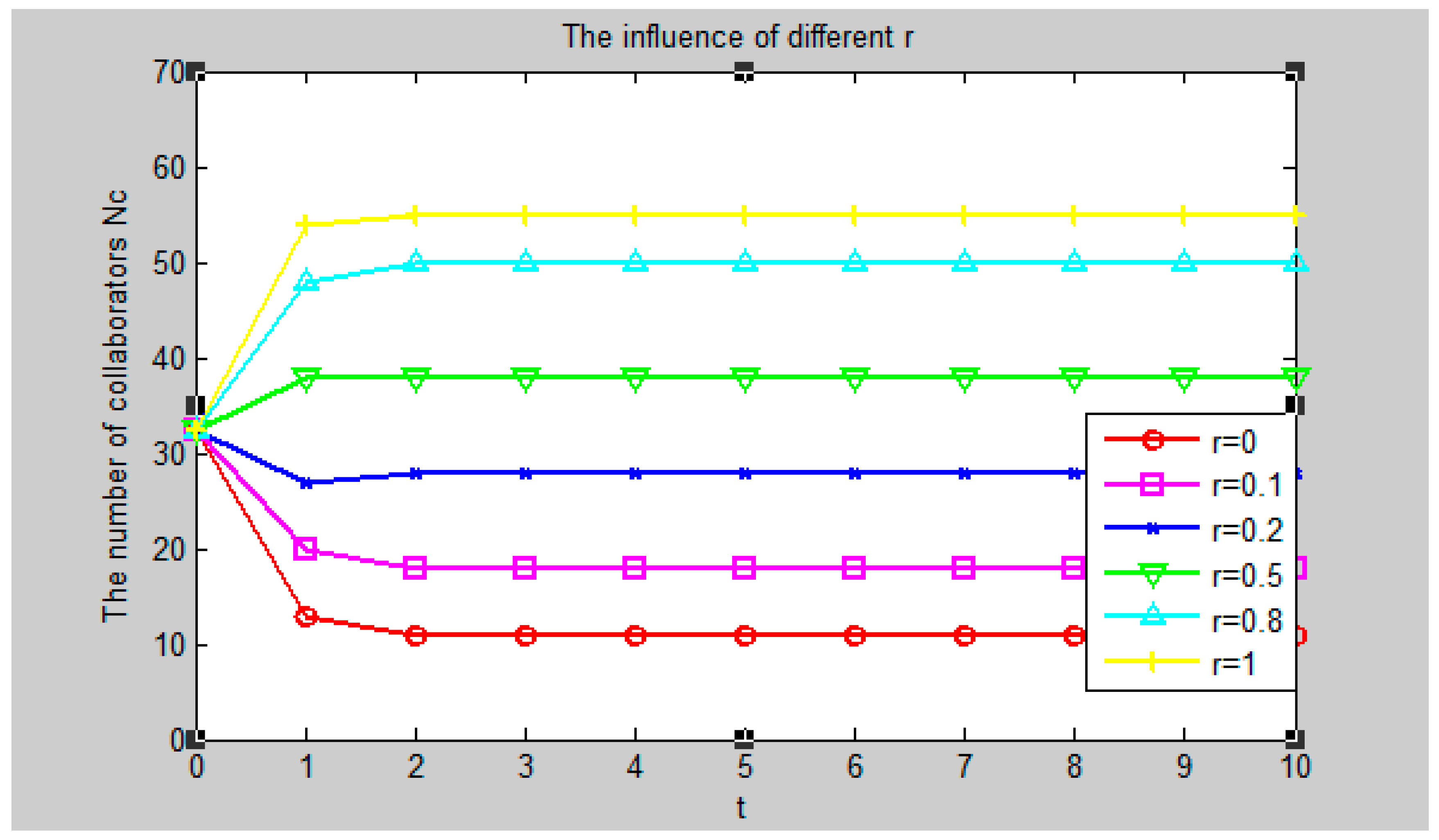
| Regions and Organizations | Countries |
|---|---|
| West Asia (17) | Bahrain, Cyprus, Greece, Iran (Islamic Republic of), Iraq, Israel, Jordan, Kuwait, Lebanon, Oman, Qatar, Saudi Arabia, State of Palestine, Syrian Arab Republic, Turkey, United Arab Emirates, Yemen |
| South Asia (8) | Afghanistan, Bangladesh, Bhutan, India, Maldives, Nepal, Pakistan, Sri Lanka, |
| Central Asia (5) | Kazakhstan, Kyrgyzstan, Tajikistan, Turkmenistan, Uzbekistan |
| Central and Eastern Europe (23) | Albania, Armenia, Azerbaijan, Belarus, Bosnia and Herzegovina, Bulgaria, Croatia, Czechia, Estonia, Georgia, Hungary, Latvia, Lithuania, Macedonia, Montenegro, Poland, Republic of Moldova, Romania, Serbia, Slovakia, Slovenia, TFYR of Russian Federation, Ukraine |
| East Asia (12) | Brunei Darussalam, Cambodia, China, Indonesia, Lao People’s Dem. Rep., Malaysia, Mongolia, Myanmar, Philippines, Singapore, Thailand, Vietnam |
| Single Game of Node i,j | Strategy of Node j | ||
| Cooperation | Betrayal | ||
| Strategy of Node i | Cooperation | R; R | S; T |
| Betrayal | T; S | P; P | |
| Variable | Description | Range |
|---|---|---|
| The belief in the sensitivity to own payoff | [0, +∞) | |
| The belief in the sensitivity to counterparts | [0, +∞) | |
| wij | The reward of i of the cooperative action given by the neighbor node j | [0, +∞) |
| f | The trade facilitation index | [0,1] |
| Y(i) | The GDP of the node country i | \ |
| r | The tariff reduction rate | [0,1] |
| Q (i, j) | The trade volume between node i and node j | \ |
© 2019 by the authors. Licensee MDPI, Basel, Switzerland. This article is an open access article distributed under the terms and conditions of the Creative Commons Attribution (CC BY) license (http://creativecommons.org/licenses/by/4.0/).
Share and Cite
Zhao, C.; Wang, Y.; Zhang, T.; Huang, Q.; Gong, Y. The Game Simulation of “The Belt and Road” Economic and Trade Network Based on the Asymmetric QRE Model. Sustainability 2019, 11, 3377. https://doi.org/10.3390/su11123377
Zhao C, Wang Y, Zhang T, Huang Q, Gong Y. The Game Simulation of “The Belt and Road” Economic and Trade Network Based on the Asymmetric QRE Model. Sustainability. 2019; 11(12):3377. https://doi.org/10.3390/su11123377
Chicago/Turabian StyleZhao, Changping, Yecheng Wang, Tianxiang Zhang, Qingbo Huang, and Yu Gong. 2019. "The Game Simulation of “The Belt and Road” Economic and Trade Network Based on the Asymmetric QRE Model" Sustainability 11, no. 12: 3377. https://doi.org/10.3390/su11123377
APA StyleZhao, C., Wang, Y., Zhang, T., Huang, Q., & Gong, Y. (2019). The Game Simulation of “The Belt and Road” Economic and Trade Network Based on the Asymmetric QRE Model. Sustainability, 11(12), 3377. https://doi.org/10.3390/su11123377






